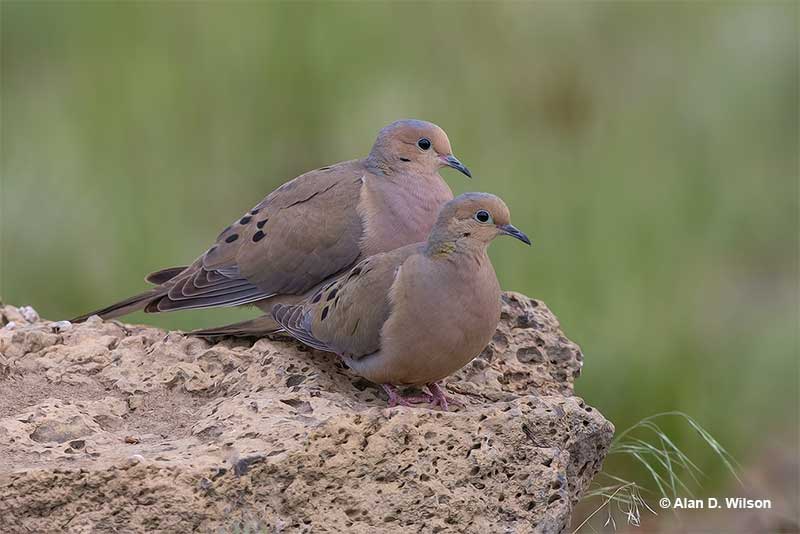
Doves are beautiful and peaceful birds! Even better, they are also common and welcome backyard bird species.
I love hearing the gentle calls of doves, especially on a cool spring morning. I know I’ll see them when I look at the backyard feeder. Depending on where you live in the USA, you might even see many different types of doves.
Which dove species live in the USA? How many doves can you see, and how can you identify them?
See this article for answers and more about the doves that live in the USA!
Types of Doves in The United States
African Collared-Dove
Size: 11 inches
Habitat: Parks, gardens, domesticated situations
African Collared-Doves are pale gray and sandy brown doves with a longish tail and fairly long wings. They have a small dark beak, a black line on the back of their neck, and short red-pink legs.
These doves also have a white undertail, and most of the underside of their tail is white. These characteristics help separate them from the very similar Eurasian Collared-Dove.
Sometimes known as White Doves, if these doves sound and look familiar, it’s because you’ve probably seen them! However, you might not have seen them in the wild. African Collared-Doves are often domesticated and available in pet shops, seen in zoos, and in other domesticated situations.
Their natural range includes arid habitats just south of the Sahara Desert and parts of the southern Arabian Peninsula. In the USA, populations of escaped African Collared-Doves have become established in many cities but are most frequent in Florida and California.
Band-tailed Pigeon
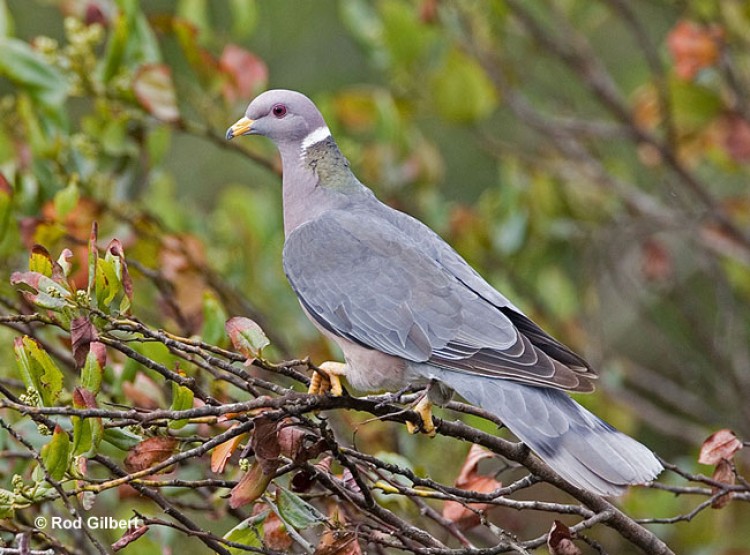
Size: 14.5 inches
Habitat: Coniferous and oak woodlands
Band-tailed Pigeons are hefty, handsome, gray and pale maroon pigeons with longish rectangular tails. They have a yellow beak with a dark tip, yellow legs, and a white mark on the back of their neck.
They also have a beautiful iridescent green patch just below that white mark and have a light gray tip on their tail.
Related: How similar are doves and pigeons?
Band-tailed Pigeons often flock together and fly fast between feeding areas. In flight, we can recognize them by their gray coloration, pale belly, dark flight feathers, and pale gray tail tip.
These large pigeons love to eat acorns, seeds, and berries, usually in tall trees. However, once in a while, we also see them on the ground, and they can come to feeders, too!
Band-tailed Pigeons live in coniferous and oak forests from Oregon to California, and in montane woodlands from Colorado to Arizona. The ones that live in the mountains migrate to lower elevations and warmer places for the winter.
Common Ground-Dove
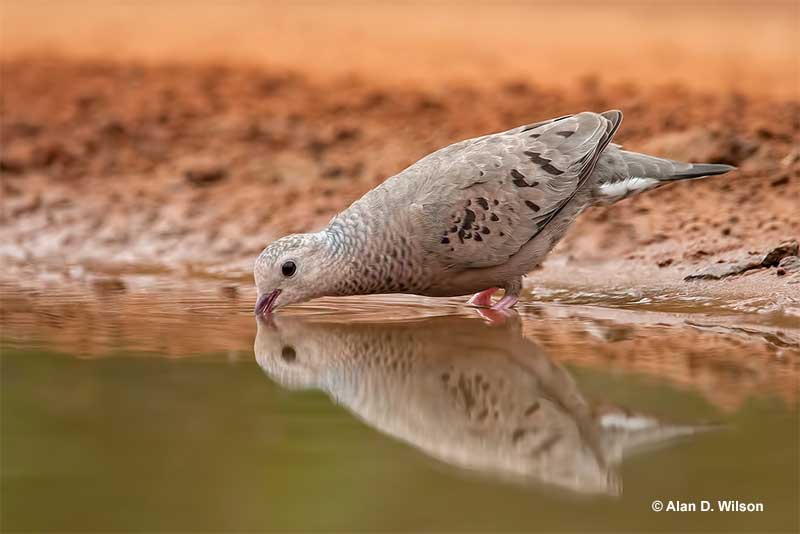
Size: 6.5 inches
Habitat: Scrub and semi-open habitats
Common Ground-Doves are so small, you might think you saw some odd sparrow! These tiny, cute doves have a plump appearance, reddish beak, and scaled markings on their head and chest. Overall, males are warm, pinkish-brown below, pale brown above, and have a pearly gray coloration on their heads.
Females resemble males but have duller plumage. Both sexes have small white corners on their short, dark tails. They show those features in flight, along with bright red-brown wing patches.
Common Ground-Doves usually occur in pairs, but once in a while, we also see them in small flocks. They like to forage for seeds on the ground, especially in dry, sandy, or open spots.
We can see these pretty little doves in Florida, southern Georgia and coastal South Carolina, and along the Gulf Coast to southern Texas. They also live in the deserts of southern California, Arizona, and part of New Mexico.
Eurasian Collared-Dove
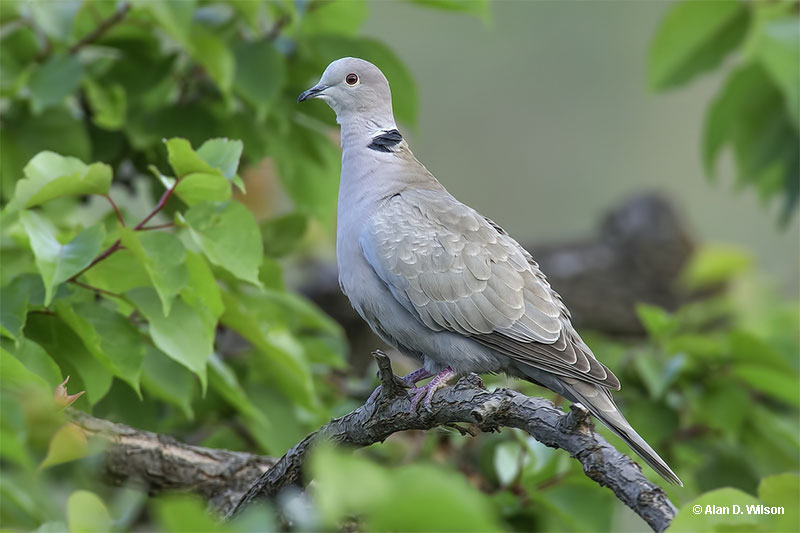
Size: 13 inches
Habitat: Towns, parks, gardens, and farms
Eurasian Collared-Doves are fairly large and slender doves with a small head and long rectangular tail. They are pale gray and pale brown above, have a small dark mark on the back of their neck, small black beak, and reddish legs.
They don’t have any dark markings on their wings but do show dark primaries in flight. When flying, it’s also easy to see the broad white band on their tail.
This dove species is one of the most successful birds in the world. Native to Europe, Eurasian Collared-Doves have become established in many other places, including the USA and Canada.
This species became established in North America after escaping or being released into the wild. Like other doves, they pick grain and seeds from the ground and can occur in flocks. Eurasian Collared-Doves are also very accustomed to people and have no problem nesting in gardens and living in towns, cities, and farms.
Inca Dove
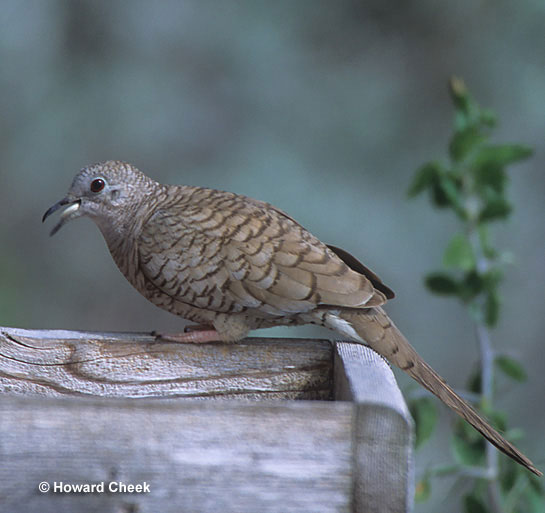
Size: 8.25 inches
Habitat: Deserts and arid scrubby habitats
The Inca Dove is a small, “mini dove” with a long, slender tail. It has a small, whitish head with a slender, dark beak, and a scaled pattern on pale gray plumage.
In flight, as Inca Doves flutter up from the ground, they show lots of white on each side of their long tail, and bright red-brown in their wings.
Both sexes look similar but females are buffier and juveniles plainer. Inca Doves like to forage for seeds on the ground, mostly in arid, open habitats. We usually see them in pairs but they can also occur in small groups that walk on the ground or perch on roadside wires.
We often hear the Inca Dove’s repeated “no hope” call in parks, towns, and scrubby habitats in Texas, and parts of the American Southwest.
In those places, these neat little birds can also visit feeders, but usually to pick up seeds that have fallen to the ground.
Mourning Dove
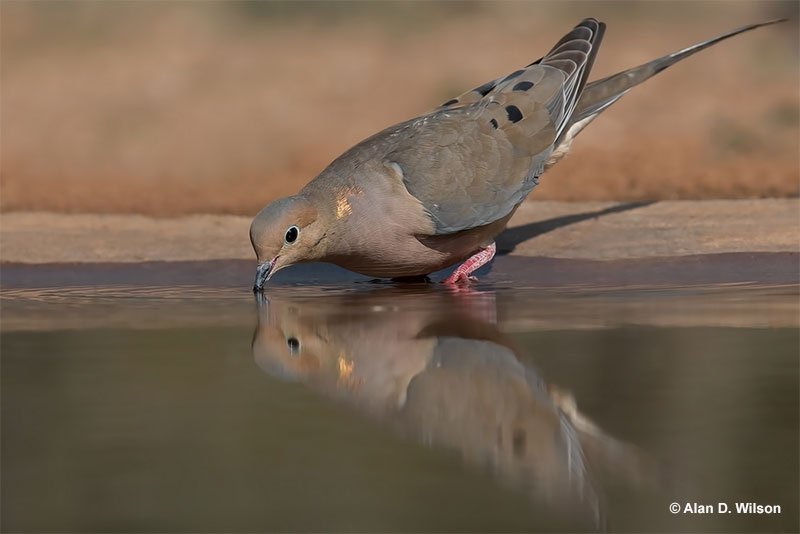
Size: 12 inches
Habitat: Parks, gardens, open woodlands
Mourning Doves are brown and gray doves with long, pointed tails. They show some pearly gray on their heads, have a buff belly, and also have a small black spot on the lower side of their head.
These familiar doves also have black spots in their longish wings and show white edging on their tails, usually in flight.
Mourning Doves often occur in pairs, but in fall and winter, they can form good-sized flocks. Like many other doves, they forage for seeds on the ground but fly pretty fast when they have to!
In most of the USA, this is the most common and familiar dove. Mourning Doves are very adaptable birds that live in towns, parks, semi-wooded areas, on farms, and other places with some trees and other bits of green space.
They live throughout the lower 48 states, and doves from the northern part of the USA and southern Canada migrate to warmer regions for the winter.
Red-billed Pigeon
Size: 14.5 inches
Habitat: Tropical and subtropical woodlands
Red-billed Pigeons are big, dark doves with dark gray and maroon colors. They have fairly uniform plumage but show darker flight feathers, especially in flight. These pretty tropical pigeons also have red-pink legs, and a pale eye.
Despite their name, Red-billed Pigeons don’t have much of a red bill! It’s actually white with a small red base that isn’t so obvious.
In flight, Red-billed Pigeons look like fairly uniform, dark pigeons with blackish tails. It’s good to know what they look like when flying because that’s how most people in the USA see them. This pigeon is a tropical species that only ranges into a few areas in southern Texas.
Unfortunately, habitat destruction has caused them to decline in Texas, and most birders can only see them on private ranches.
In the USA, Red-billed Pigeons usually occur in small flocks that wander in search of fruiting trees that they feed on.
Rock Pigeon
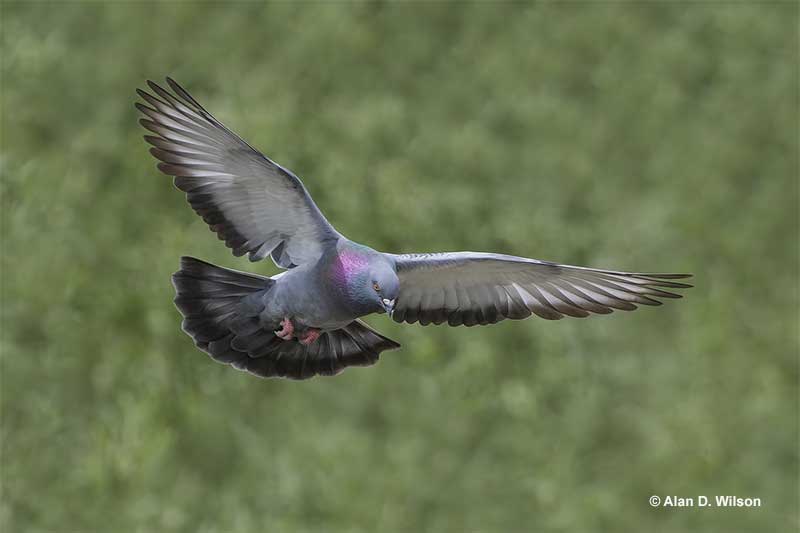
Size: 12.5 inches
Habitat: Cities, towns, and farmlands
Rock Pigeons are the common and familiar city pigeons. Although they can show various types of plumage, the most common ancestral plumage is gray with a darker gray head and neck and white rump.
Rock Pigeons also have two black marks on their long wings, a gray tail with a black tip, and reddish legs. If you care to look closely, you’ll also notice that Rock Pigeons have red eyes, a white mark on the base of their beaks, and beautiful green and purple iridescence on their necks.
Related: Are albino pigeons actually doves?
These familiar birds are a regular sight in towns and cities and in farmlands. They forage for seeds and other bits of food on the ground, often occur in flocks, and nest on ledges and other flat, sheltered structures.
In urban areas, some people feed Rock Pigeons, and they can act as a peaceful reminder that nature persists, even in the city.
White-crowned Pigeon
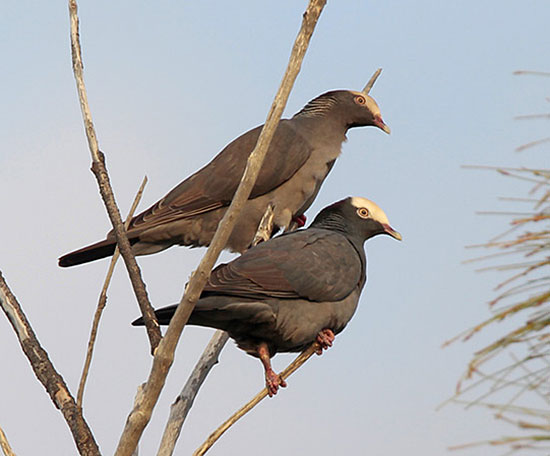
Size: 13.5 inches
Habitat: Tropical woodlands on islands
White-crowned Pigeons are dark, blackish-gray doves with bright white crowns. Both sexes look the same and also have golden-green iridescence on the back of the neck, white eyes, and reddish beaks and legs.
Juvenile White-crowned Pigeons have dark plumage like the adults but lack their white crown and pale eyes.
In flight, these doves look like blackish-colored pigeons with snow-white caps. They can occur in pairs but also form flocks that feed in a variety of tropical fruiting trees.
White-crowned Pigeons are island specialists that live in the Caribbean region. In the USA, we mostly see them in the Florida Keys as they forage in fruiting trees, and fly between the islands.
This dove species often roosts in one area and then flies to other feeding areas, even other islands. They are quick fliers that can wander in their search for food. Sadly, these striking pigeons are threatened by habitat loss and hunting in some parts of their range.
White-tipped Dove
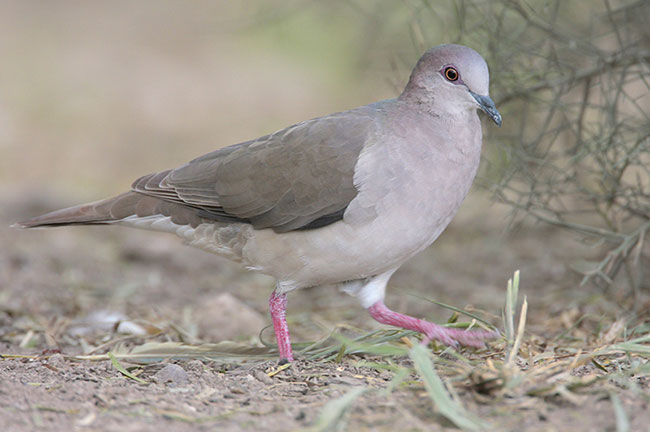
Size: 11.5 inches
Habitat: Subtropical scrub and wooded habitats
White-tipped Doves are plump, plain doves with a pale gray-brown back and tail, and a pale gray head and underparts. They have some white on the face, pink iridescence on the back of their neck, and reddish legs.
These doves also have black and white tips on the corners of their rectangular tails, and show a white belly and red-brown underwings in flight.
White-tipped Doves can forage in pairs but are also seen on their own. They don’t usually form flocks like other dove species and spend most of their time on the ground. These doves walk through wooded and scrubby habitats as they search for seeds and other bits of food.
When frightened, they fly up and into a tree, and also give their mournful call while perched.
For the most part, the White-tipped Doves is a tropical species that only ranges into the USA in southern Texas.
White-winged Dove
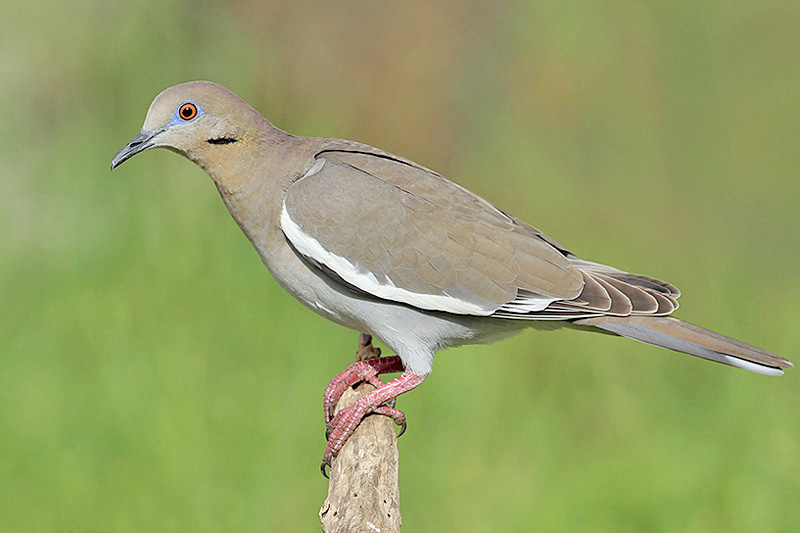
Size: 11.5 inches
Habitat: Deserts, towns, farmlands, and other open habitats
White-winged Doves are pale brown-gray doves with a big white patch in each wing. They also have a small black mark on the lower side of their face, a longish, rectangular tail, and reddish legs. The black and white tip on their tail is easiest to see when they fly.
Both sexes look the same, and juveniles look like adults but have a paler face.
Like most doves, White-winged Doves also pick seeds and grain from the ground. They like to feed in open, arid areas but can also occur in towns. We can see them in pairs or in big flocks. In some farming areas, those big flocks of White-winged Doves can number in the thousands!
This species mostly lives in Mexico and Central America. However, White-winged Doves have become common birds in the southwestern states and in southern Florida. They have also been seen in other spots and are expanding to the north.
Frequently Asked Questions
How many types of doves do we have?
In the USA, we have 20 types of doves. Five species are introduced and seven are vagrant migrants from Eurasia, the Caribbean, and Mexico.
How many dove species are there in the world?
There are 353 dove species in the world. That includes pigeons, quail-doves, cuckoo-doves, and some extinct species.
What are the most common doves?
The most common doves are Mourning Doves. In most of the USA, this is the most common dove species.
Is a pigeon the same as a dove?
Yes, a pigeon is the same as a dove. In general, doves are smaller and pigeons are larger but they belong to the same family.
Are doves and Mourning Doves the same?
Doves and Mourning Doves are the same. The Mourning Dove is a type of dove, and there are also other dove species.



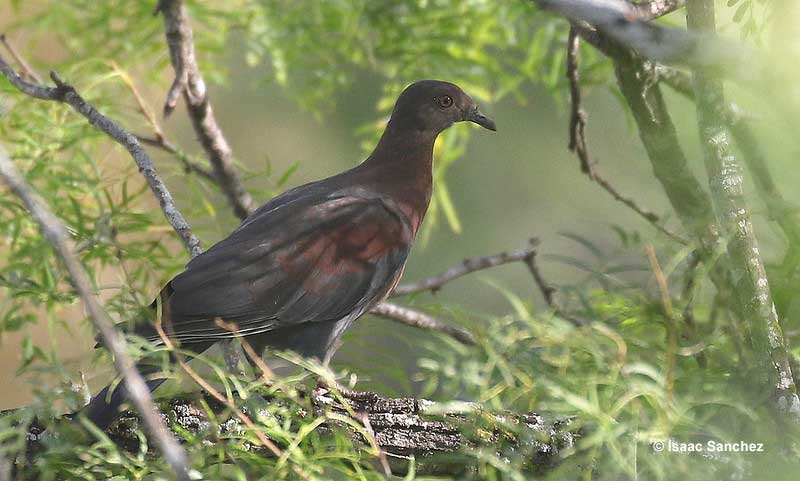
Rit Hope
Wednesday 10th of April 2024
I’m trying to figure out why there has been a strong association between doves and the color white? All that’s portrayed, at least what I’ve seen, are pictures of white doves with the proverbial olive branch, and there’s even various dove paints, all of which are white. Since doves come in a variety of colors, but yet all I see are white doves portrayed, is there an actual dove that’s completely white?
Patrick O'Donnell
Friday 12th of April 2024
@Rit Hope- In nature, there actually aren't that many dove species with white plumage. Usually white doves are rare albino or leucistic birds. However, some Eurasian and African collared-dove species are very pale. Since these doves often live near people, they might be the original "white doves" that have been associated with religious symbolism since ancient times.
Chrissy
Tuesday 9th of April 2024
I was just coming home from work and I saw my normal neighborhood doves on the side of the road but, something was off. I noticed the normal blue-ish gray colors then I noticed a light tan colored bird with a dark brown head and neck. I have no idea of what this bird was. I should have taken a photo but I was too busy watching it. When the other birds took off that bird flew away with them. Since the doves usually stay around here maybe I can get a photo soon. Do you have any idea of what it might be??? It looked like the others body wise. Ty,
Patrick O'Donnell
Tuesday 9th of April 2024
@Chrissy- Off hand, it sounds like one of the plumages that a Rock Pigeon can have. However, it's hard to say what it might have been. To figure out bird identifications, it also helps to know where the bird was seen. In which part of the country do you live? Hopefully you'll see it again and get a picture!